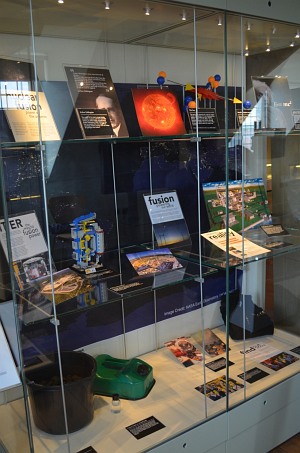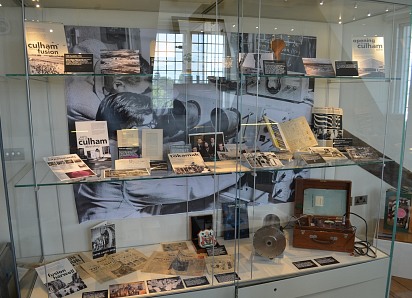Today was Summer Solstice and the longest day. The Sun is powered by nuclear fusion reactions in which lighter elements, like hydrogen, release energy to form heavier elements, like helium.

A new exhibition, at Abingdon County Hall Museum, takes you behind the scenes, to learn about the history of research at Culham to try to set off fusion reactions here on earth, and revolutionise electricity generation. The exhibition runs until 18 October 2015 in the Attic Gallery at the museum – see Star Power.

This year marks the 50th Anniversary of fusion reseach at Culham, and the exhibition tells the story of the Culham site, from wartime days as a naval airfield (HMS Hornbill) through to the many fusion machines that have been built over the years including the European JET project.
Up to now the energy needed to start the fusion reaction is more than the energy generated. But the next generation of even bigger fusion machines could bring star power down to earth.
P.S. The Culham researchers, in the big white building next to the A415 in Culham, have free Open Evenings most months, which can be booked at http://www.ccfe.ac.uk/visits.aspx.
I remember visiting the Joint European Torus (JET) in February 1987, and standing in the centre of the chamber of what was then the worlds largest tokamak – the name being derived from the Russian for toroidal magnetic chamber. I can still recall the feeling of being dwarfed by the enormous, shiny chamber and awed at its potential power, which has yet to bear fruit. The group I was with were told that the planning permission had been granted for 20 years, after which it would be dismantled and returned to fields!
Limitless power without any polluting by-products would seem to be the holy grail of physics but that would be thermo-nuclear fusion at room temperature!!
I shall have to make the formidable effort to climb the stairs to the museum; they can heat plasma to hundreds of millions of degrees, but couldn’t extend the lift to the museum!!!
I, too, remember visiting in the early days (late 1970s, I think, when I was working at the then Oxford Poly). It was an extraordinary piece of research – and remains so; if it can result in clean energy, it will have proved an amazing triumph.
After 50 years, fusion energy has yet to power a single light bulb, and sadly nor will it ever. The idea of course is very seductive but in reality it is simply too complex. Even after all this time, there is no consensus as to exactly how the power or the bred tritium can be extracted. The experience of building ITER (a very simple machine compared to any real device) has shown the massive cost of fusion.